Home Heating Solutions
Heat Pumps and Zoning Systems: Customizing Comfort Room by Room
Achieve ultimate comfort in your home with heat pumps and zoning systems, but discover how they can transform your energy efficiency even further.

Heat pumps combined with zoning systems let you customize comfort in each room, ensuring that your home feels just right. By using multiple thermostats, you can control temperatures independently, eliminating disputes over thermostat settings. This setup directs heating and cooling only where it's needed, which can save you up to 30% on energy bills. It's especially beneficial for multi-level homes or spaces with varying temperature needs. Plus, regular maintenance keeps everything running smoothly. Interested in learning how to optimize your home's comfort and efficiency even further? There's plenty more to uncover about these systems.
Key Takeaways
- HVAC zoning systems allow personalized temperature control in different rooms, enhancing comfort and energy efficiency.
- Heat pump zoning utilizes multiple thermostats and dampers for precise airflow management, addressing hot and cold spots effectively.
- Energy savings of up to 30% can be achieved by targeting heating and cooling in occupied spaces only.
- Initial assessments by licensed HVAC contractors ensure effective zoning system installation tailored to home layout and size.
- Regular maintenance, including filter cleaning and annual inspections, is vital for optimal performance and longevity of heat pump zoning systems.
Understanding HVAC Zoning
Understanding HVAC zoning means recognizing how it can transform your home's comfort and energy efficiency. By dividing your home into distinct zones, each with its own thermostat, you gain personalized temperature control. No more fighting over the thermostat settings among family members!
In a multi-zone system, dampers in your ductwork open and close to manage the specific heating and cooling needs of each area, allowing for independent climate management. This customization is particularly effective when paired with advanced systems like refrigerant heat pumps that enhance temperature regulation through efficient thermal energy transfer.
This zoning is especially beneficial in multi-story homes, where temperature disparities can be a real issue. With HVAC zoning, you can target heating and cooling precisely, ensuring every room remains comfortable.
Plus, by optimizing these processes, you'll see significant energy savings, as you won't waste energy on unoccupied rooms.
If your home has unique architectural features or fluctuating occupancy rates, zoning systems will enhance your overall comfort and energy efficiency. They effectively address uneven temperature distribution, improving your indoor air quality and creating an environment where everyone feels at ease.
With HVAC zoning, you're not just adjusting the temperature; you're elevating your entire living experience.
How Zoning Systems Work

Zoning systems operate by using multiple thermostats placed throughout your home, each responsible for its own specific area. This setup allows for personalized temperature management, so you can keep different rooms at their ideal comfort levels.
Each thermostat communicates with a central control panel, which regulates HVAC dampers in the ductwork. These dampers automatically open and close based on the signals they receive, directing heating and cooling to specific zones as needed.
Incorporating advanced technology like garage door openers can enhance overall home security while maintaining comfort in different areas. When you adjust the temperature on one thermostat, the central control panel guarantees that the airflow adjustments occur without affecting other areas of your home.
This precise temperature control means you can easily accommodate different preferences among family members. By optimizing airflow and targeting heating and cooling efforts, zoning systems enhance energy efficiency, potentially lowering your utility bills.
Benefits of Zoning Systems
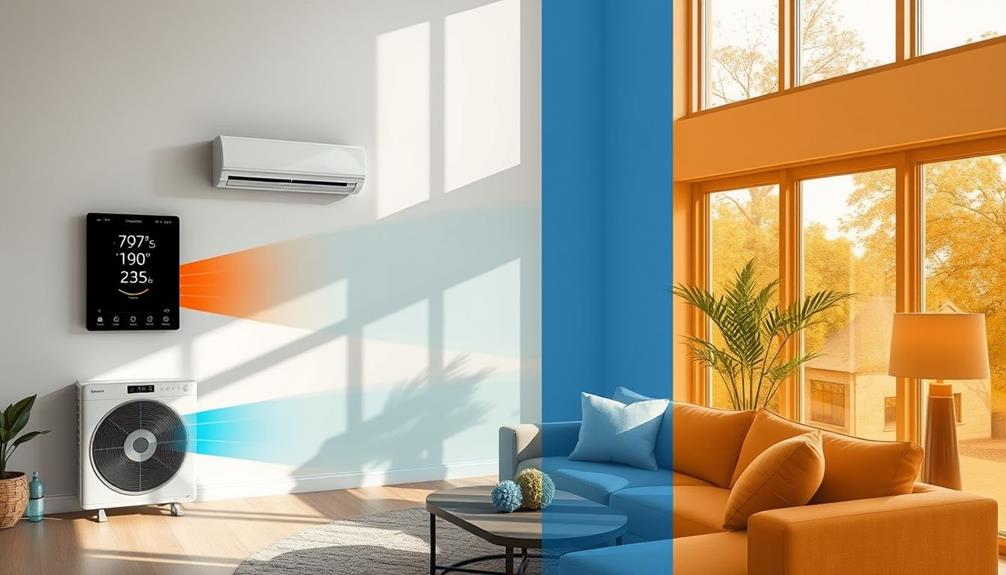
Zoning systems give you the power to control temperatures in different areas of your home, making it easier to keep everyone comfortable without constant thermostat battles.
By focusing on heating and cooling only where needed, you could save up to 30% on energy costs compared to traditional systems. This energy efficiency is similar to the strategies for optimizing performance in mountainous training.
Plus, with programmable thermostats for each zone, you can tailor schedules to fit your lifestyle, maximizing both comfort and efficiency.
Enhanced Comfort Control
With customized temperature settings in various areas of your home, enhanced comfort control becomes a reality. A zoned HVAC system allows you to tailor the climate to your individual preferences, giving you the power to make temperature adjustments room by room. This means you can enjoy a cozy living room while keeping the kitchen cooler—perfect for cooking!
Additionally, implementing a well-designed zoning system can be as effective as choosing the right best room fans for summer cooling to maintain comfort in warmer months.
By utilizing dampers that direct airflow to different zones, you'll eliminate hot and cold spots, ensuring a consistently pleasant environment throughout your home. This increased comfort control means you'll never have to compromise on temperature again, whether it's a chilly winter evening or a hot summer day.
Moreover, zoning systems can lead to significant energy savings. Since heating and cooling are only directed to occupied spaces, you're not wasting energy on areas that aren't in use.
Your control over your indoor climate not only enhances your comfort but also contributes to overall satisfaction with your home environment. By embracing this technology, you'll enjoy a personalized experience that adapts to your lifestyle and needs, making every moment spent at home that much more enjoyable.
Energy Efficiency Savings
You can greatly boost your home's energy efficiency with a well-implemented zoning system. By allowing precise temperature control in different areas, you'll see significant energy savings on your heating and cooling costs.
Understanding the financial implications of divorce can also help you budget for home improvements like these. Here are three key benefits:
- Targeted Heating and Cooling: Smart zoning systems adjust temperatures in occupied rooms while reducing energy consumption in unoccupied rooms, minimizing waste.
- Programmable Thermostats: These devices optimize your heating and cooling schedules, adapting to your lifestyle and ensuring that energy isn't wasted when you're not home.
- Lower Utility Bills: With a zoning system, you can enjoy reduced energy costs, leading to a lower overall utility bill.
Investing in a zoning system not only enhances your comfort but also provides a solid return on investment, often recouped in just 3 to 5 years.
Plus, by reducing energy consumption, you're contributing to environmental sustainability goals while improving your home's energy efficiency.
With the right setup, you can enjoy the benefits of a comfortable living environment and significant savings.
Ideal Candidates for Zoning
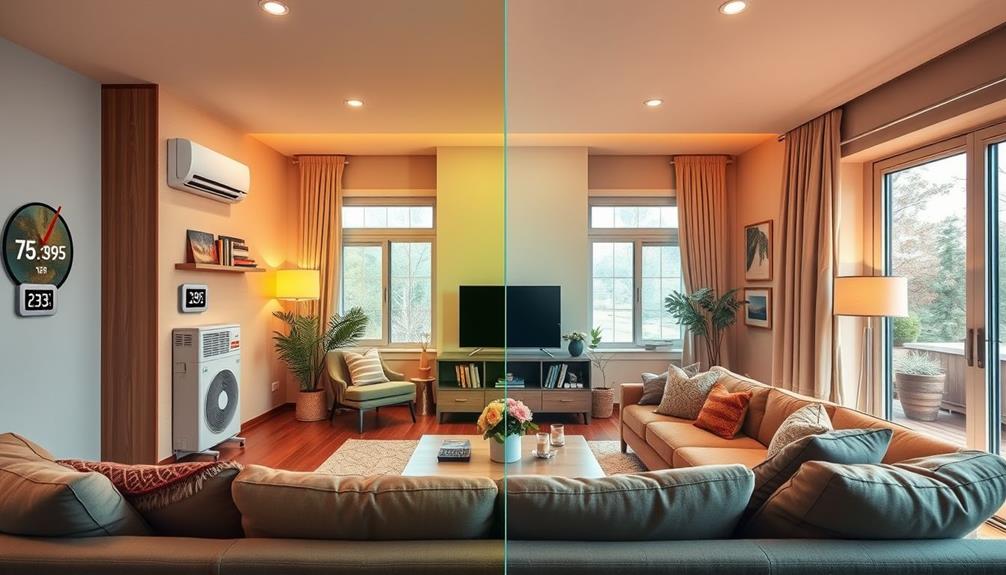
If you live in a multi-level home, zoning systems can help balance the temperature throughout different floors, making your space more comfortable.
This is especially beneficial for homes with diverse landscapes, such as those near New England Camping Highlights, where varying temperatures can be experienced in different areas.
You'll also see energy efficiency gains by directing heating and cooling only where it's needed, cutting down on energy waste.
Whether your home has unique architectural features or an open floor plan, zoning can enhance your overall comfort and efficiency.
Multi-Level Home Benefits
Maximizing comfort in multi-level homes often requires tailored heating and cooling solutions, making zoning systems a perfect fit. These systems address common issues like temperature fluctuations and hot and cold spots, guaranteeing that every area of your home feels just right.
Additionally, integrating energy-efficient technologies, such as geothermal energy generation, can further enhance comfort while minimizing environmental impact.
Here are some key benefits of implementing an HVAC zoning system in your multi-level home:
- Customized Heating and Cooling: With individual thermostats for each zone, you can set different temperatures for upstairs and downstairs areas based on usage and personal preferences.
- Improved Comfort Control: Zoning systems allow you to direct heating or cooling only to occupied rooms, enhancing overall comfort throughout your home.
- Energy Savings: By reducing energy consumption in unoccupied areas, you'll not only achieve better energy efficiency but also lower your utility bills.
For multi-level homes, especially those with unique architectural features like vaulted ceilings or large windows, zoning systems optimize air distribution, maintaining consistent comfort throughout the living space.
Energy Efficiency Gains
Zoning systems not only enhance comfort in multi-level homes but also offer significant energy efficiency gains. By allowing targeted heating and cooling in occupied areas, these systems can reduce energy consumption by up to 30% compared to traditional setups. This aligns with the growing trend towards healthier lifestyle blogs, where energy efficiency contributes to overall well-being.
If you live in a multi-story home or a space with large open areas, zoning can effectively manage temperature disparities, helping you save on energy bills.
Incorporating smart thermostats into your zoned heat pump system can further boost energy efficiency. Studies indicate you could save an additional 10-30% on heating and cooling costs through optimized scheduling and remote management.
Plus, multi-zone systems generally lead to longer lifespans for your HVAC equipment. By conditioning only the spaces you use, these systems lighten the workload on your units, resulting in maintenance savings of up to 25%.
Implementing a zoning system not only improves your home's energy efficiency rating but also makes it more attractive to potential buyers, potentially increasing property value by 5-10%.
With these significant benefits, zoning systems are ideal candidates for anyone looking to enhance comfort while maximizing energy efficiency.
Heat Pump Zoning Explained

When it comes to achieving comfort in your home, heat pump zoning systems offer a smart solution. By using multiple thermostats connected to a central control panel, you can enjoy precise temperature regulation in different areas of your home.
This system is particularly effective in addressing hot and cold spots, guaranteeing you experience customized comfort throughout. Utilizing essential home cleaning kit items can help maintain a clean environment that complements your comfortable living space.
Here are three key benefits of heat pump zoning:
- Energy Efficiency: By directing heating or cooling only to occupied areas, you can potentially lower your utility bills by up to 30%.
- Ductwork Dampers: Each zone is equipped with dampers that adjust airflow based on the individual thermostat settings, enhancing overall comfort.
- Regular Maintenance: Keeping your system in top shape—like cleaning filters and checking refrigerant levels—is vital for peak performance and longevity.
With heat pump zoning, you can create a comfortable living environment tailored to your lifestyle. This approach not only maximizes energy efficiency but also guarantees that every room in your home feels just right.
Energy Efficiency Considerations
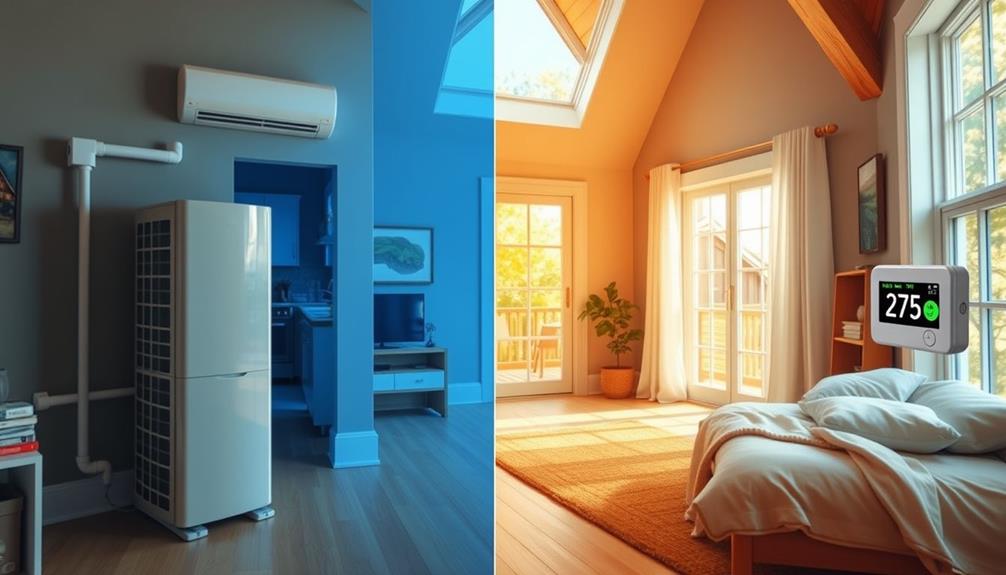
Achieving energy efficiency with heat pump zoning systems can considerably lower your utility bills while enhancing comfort.
Multi-Zone Heat Pump Systems allow you to maintain precise control over your home's temperatures, targeting areas you're using while minimizing energy consumption in unoccupied spaces. This approach can lead to significant cost savings—studies show homes with zoning systems can save up to 30% on heating or cooling costs.
Additionally, it's important to evaluate assessing risks and rewards associated with various energy-saving technologies to guarantee long-term benefits for your home.
By utilizing variable-capacity operation, these systems guarantee that energy use is tailored according to your current needs, instead of running at full capacity all the time. This not only enhances energy efficiency but also promotes a more sustainable home environment by reducing reliance on fossil fuels.
Incorporating smart thermostats within your zoning systems further increases energy efficiency. They allow you to monitor and adjust temperatures remotely, creating tailored schedules that fit your daily routines.
This level of control guarantees you achieve ideal comfort without unnecessary energy waste. With these advancements, you'll enjoy a more comfortable living space while making a positive impact on your budget and the environment.
Installation Insights
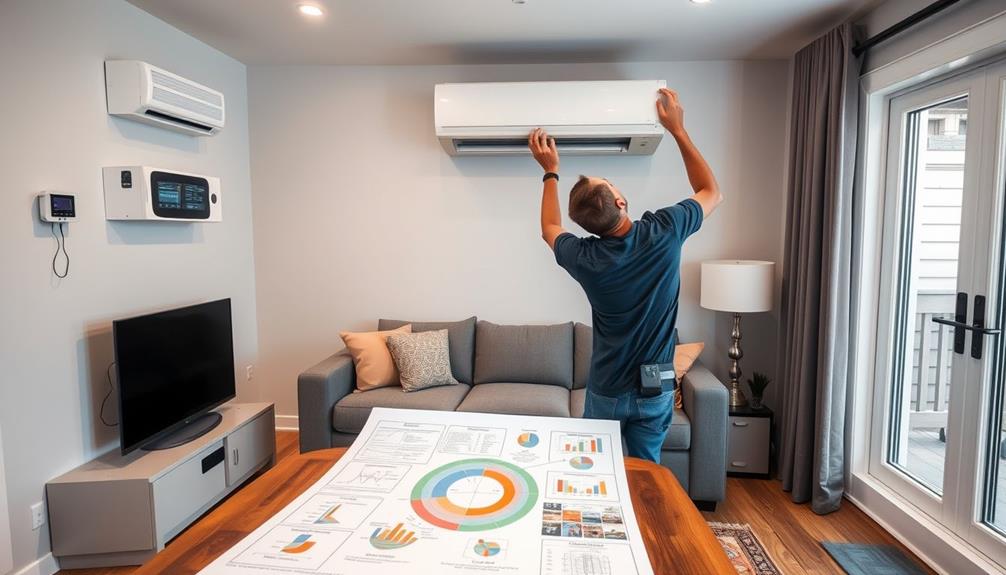
Installing a multi-zone heat pump system can greatly enhance your home's comfort and energy efficiency. To guarantee a successful installation, you'll want to follow these key steps:
- Assessment: Consult a licensed HVAC contractor to evaluate your home layout and climate. This initial assessment is vital for effective zoning, as it helps determine the best placement for thermostats and automated dampers.
- Installation Options: Depending on your home's existing ductwork, you might choose to integrate it or opt for ductless systems if space is limited. This flexibility allows for tailored solutions that fit your specific needs.
- System Programming: Once the installation is complete, programming your system is essential. This step lets you set desired temperatures and schedules for each zone, optimizing both comfort and energy efficiency.
Post-installation support and maintenance options are equally important for guaranteeing long-term performance.
Maintenance Best Practices

Maintaining your heat pump zoning system is crucial for guaranteeing ideal performance and longevity. Start by cleaning or replacing air filters every 1-3 months. This simple maintenance step guarantees optimal airflow and energy efficiency, helping your system maintain the desired temperature across all zones.
Scheduling annual inspections with certified professionals is another important practice. These experts can identify and rectify potential issues early, extending your system's lifespan and maintaining balanced performance in every room.
Don't forget to monitor refrigerant levels; inadequate refrigerant can lead to decreased efficiency and possible damage to your heat pump system.
Routine cleaning of the outdoor unit is also essential. Keeping it free from debris improves heat exchange efficiency, contributing to overall system performance.
Finally, guarantee the area around indoor units is clear of obstructions. This allows for better air circulation and guarantees your zoning system operates effectively in all designated areas.
Choosing the Right System
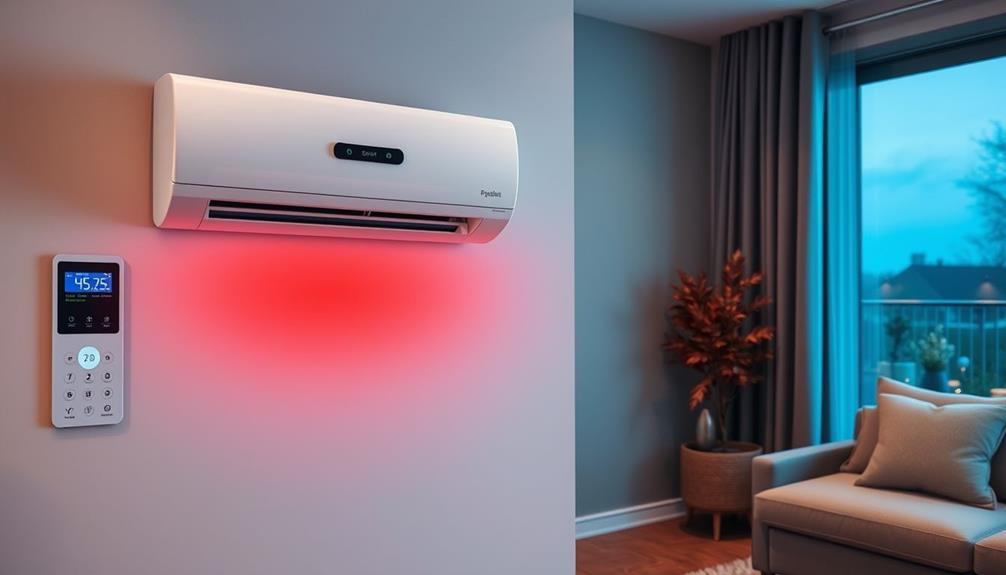
Selecting the right heat pump zoning system can greatly enhance your home's comfort and efficiency. When making this important choice, consider the following factors to guarantee you find the best fit for your needs:
- Home Layout and Size: Multi-story and larger homes benefit more from customized temperature controls. This guarantees each area maintains the ideal climate, addressing varying heating and cooling requirements.
- Type of Heat Pump: Evaluate options like air-source, ground-source, and ductless systems. Each provides flexible solutions tailored to your home's specific room configurations and insulation levels.
- Installation Costs and Energy Savings: Initial costs for heat pump installation can range from $3,000 to $7,000. However, consider long-term energy savings and available rebates that can considerably offset these expenses.
Consult with certified HVAC professionals to guarantee proper installation and system design tailored to your home's unique requirements.
By prioritizing advanced technology like inverter-driven compressors, you'll improve energy efficiency and achieve better temperature control throughout your home.
Investing time in these considerations will lead to an effective zoning system that maximizes comfort and energy savings.
Frequently Asked Questions
Can You Have Zones With a Heat Pump?
Yes, you can definitely have zones with a heat pump. By using multiple thermostats and dampers, you can control temperatures independently in different areas, enhancing your comfort and improving energy efficiency throughout your home.
Can Zoned HVAC System Customize Temperature According to an Area?
Yes, a zoned HVAC system lets you customize temperatures in different areas of your home. You can set specific settings for each zone, ensuring everyone enjoys their preferred comfort level while maximizing energy efficiency.
Are Zoned HVAC Systems Worth It?
Zoned HVAC systems are worth it if you want personalized comfort and energy savings. They reduce utility bills and enhance air quality, making your home more enjoyable while addressing everyone's individual temperature preferences.
Can Heat Pumps Have Multiple Zones?
Think of your home as a symphony, where each room plays its own melody. Yes, heat pumps can have multiple zones, allowing you to fine-tune temperatures to your liking and enjoy personalized comfort throughout your space.
Conclusion
Incorporating zoning systems with heat pumps can transform your home's comfort levels, allowing you to customize temperatures room by room. Did you know that homes with zoning systems can save up to 30% on their energy bills? By adapting your heating and cooling to your specific needs, you not only enhance comfort but also boost efficiency. So, if you're looking to maximize both comfort and savings, consider investing in a zoning system today!
Home Heating Solutions
The Psychology of Comfort: Why Heat Pumps Provide Better Living Experiences
Unlock the secrets of how heat pumps enhance comfort and well-being, leaving you curious about their profound impact on your living experience.

Heat pumps create ideal indoor environments that enhance your overall comfort and well-being. By providing consistent, perfect temperatures, they boost your mental clarity and emotional stability. You'll notice fewer feelings of irritability and fatigue, promoting a more productive atmosphere. These systems not only save you money on energy bills but also improve indoor air quality by reducing allergens and pollutants. The positive impacts extend beyond comfort, benefiting your health, mood, and productivity. Discover more about how these energy-efficient systems can transform your living experience and contribute to a sustainable future.
Key Takeaways
- Comfortable indoor temperatures provided by heat pumps enhance mental clarity and emotional stability, promoting a positive living experience.
- ASHPs improve indoor air quality, reducing allergens and pollutants, which supports overall health and well-being.
- Consistent temperature control from heat pumps minimizes physical discomfort and irritability, contributing to a more enjoyable home environment.
- Energy efficiency of heat pumps leads to significant cost savings, allowing residents to invest more in their quality of life.
- The dual functionality of ASHPs ensures year-round comfort, fostering a sustainable and enjoyable living atmosphere.
Impact of Temperature on Mental Health
Temperature plays an essential role in your mental health, influencing how you feel and think. When you're in an indoor environment with comfortable temperatures, you're likely to experience improved mental clarity and emotional stability. Properly functioning systems, such as refrigerant heat pumps, help maintain these ideal conditions.
On the flip side, excessive cold can make you irritable and lead to negative emotions, while warmer temperatures often boost your mood. Prolonged exposure to extreme temperatures can cause physical discomfort, which negatively impacts your overall mental health. Maintaining reasonable temperatures in your workspace is vital.
A comfortable indoor climate not only enhances your mood but also fosters harmonious teamwork and collaboration with your colleagues. Energy efficiency matters too; by using systems like heat pumps, you can achieve those ideal temperatures without wasting energy.
This balance not only promotes positive emotional stability but also contributes to better workplace relationships. By prioritizing your indoor environment's temperature, you're taking a significant step toward enhancing your mental well-being.
Productivity and Employee Self-Worth

A comfortable workplace environment not only enhances mental well-being but also plays a significant role in productivity and employee self-worth. When you're in a space with ideal indoor temperature, you're less likely to feel tired or apathetic, which can derail your motivation. Effective heating systems, like air source heat pumps, maintain a consistent temperature, allowing you to focus on your tasks without distraction.
Additionally, integrating home comfort solutions such as ergonomic recliners and efficient heating systems can further improve the overall workplace atmosphere.
Moreover, when you feel physically comfortable at work, it reflects positively on how you perceive your employer. A caring environment boosts your self-esteem, making you more inclined to perform at your best. This sense of value contributes to improved mental health, promoting a culture where appreciation and collaboration thrive.
Research confirms that higher productivity levels correlate directly with comfortable working conditions. By investing in proper temperature management, your workplace can foster an atmosphere where you and your colleagues can thrive.
Ultimately, comfort isn't just a luxury; it's an essential element for enhancing productivity and reinforcing your sense of self-worth in the workplace. Prioritizing a comfortable environment can lead to remarkable improvements in overall job performance and happiness.
Overview of Air Source Heat Pumps

Air source heat pumps (ASHPs) offer an energy-efficient way to keep your home comfortable all year long.
By using outside air, these systems can greatly lower your utility bills while providing both heating and cooling.
Additionally, air purifiers help reduce allergens and pollutants, enhancing indoor air quality, which complements the overall comfort that ASHPs provide.
Plus, with their ability to reduce carbon emissions, ASHPs not only benefit your wallet but also the environment.
Energy Efficiency Benefits
While traditional heating and cooling systems can drain your energy resources, air source heat pumps (ASHPs) offer a remarkably efficient alternative.
These systems demonstrate impressive energy efficiency, consuming considerably less electricity while providing effective heating and cooling. You can save energy by achieving savings of 300% to 400% compared to conventional systems.
Additionally, opting for air source heat pumps can be part of a broader strategy for sustainable living, similar to how gout management insights emphasize dietary adjustments for overall health.
Here are some key benefits of ASHPs:
- Reduced Heating Costs: Cut your heating expenses by up to 50%, potentially saving between $300 and $650 annually.
- Lower Carbon Emissions: Enjoy a sustainable choice that can lessen emissions by up to 93% nationwide.
- Dual Functionality: Rely on one system for both heating in winter and cooling in summer, optimizing energy use year-round.
- Space Efficiency: Installation often requires minimal space and can utilize existing duct systems, making it an attractive option for various homes.
Year-Round Comfort Solutions
Providing a reliable solution for all-season comfort, air source heat pumps (ASHPs) efficiently adapt to your home's heating and cooling needs. These systems utilize outside air to provide both heat and cooling, guaranteeing you experience ideal indoor temperatures year-round.
When it comes to heating, ASHPs can reduce your heating costs by up to 50% compared to traditional methods, delivering significant long-term savings. Additionally, regular maintenance of your HVAC system, akin to toilet maintenance practices, can extend the lifespan and efficiency of your ASHP.
ASHPs operate quietly, enhancing your indoor air quality by minimizing allergens and pollutants, which contributes to a healthier living environment. Their dual functionality allows for quick temperature adjustments, guaranteeing consistent comfort without excessive energy consumption. This efficiency means you can maintain your desired indoor climate with ease.
Moreover, ASHPs help manage humidity levels, preventing respiratory discomfort and promoting overall well-being throughout the year. By effectively meeting seasonal climate demands, they guarantee you're comfortable no matter the weather outside.
Investing in an ASHP not only enhances your home's comfort but also supports a sustainable lifestyle by utilizing energy more efficiently. With ASHPs, you can enjoy warmth in winter and cool air in summer, making them an ideal choice for year-round comfort solutions.
Environmental and Economic Benefits
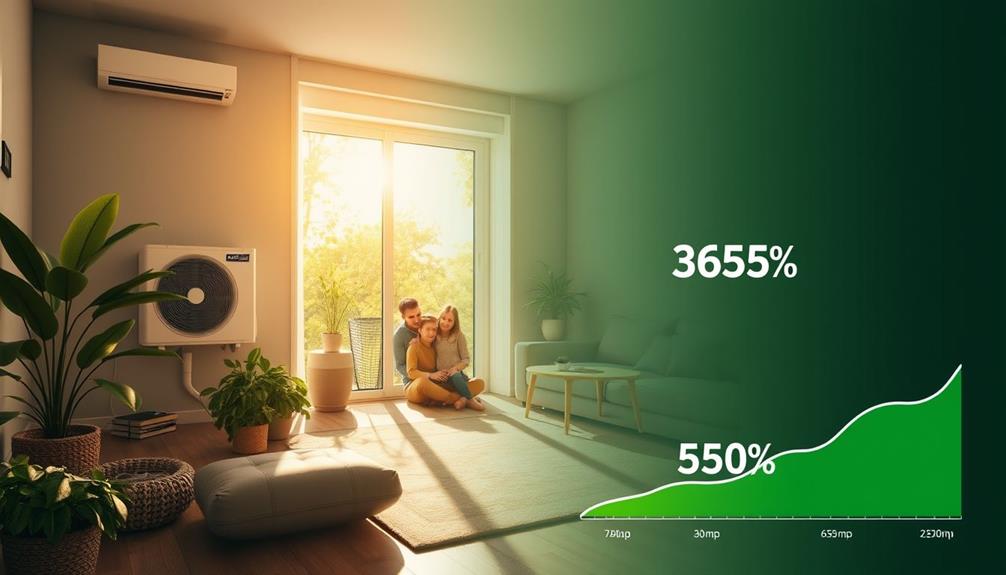
When you switch to an air source heat pump, you can enjoy significant cost savings on your energy bills, cutting heating costs by up to 50%.
Additionally, the benefits of diversifying your energy sources can lead to a more sustainable future, similar to how diversification of retirement portfolio is essential in volatile economic climates.
Not only will your wallet thank you, but you'll also be reducing your carbon footprint, contributing to a greener planet.
With incentives available, investing in an ASHP makes both economic and environmental sense.
Cost Savings Over Time
By choosing to install a heat pump, you can greatly reduce your energy bills and contribute to a healthier planet. Heat pumps are incredibly energy-efficient, allowing you to save between $300 to $650 annually on utility bills. This significant reduction occurs because they consume far less energy than traditional heating sources, aligning with the growing trend of plant-based diets for health and sustainability.
You can also take advantage of various financial incentives that further enhance your savings. Consider these benefits:
- Federal tax credits that lower your upfront costs
- State-specific rebates that make installation more affordable
- Long-term cost-effectiveness due to lower maintenance expenses
- Durability, ensuring your investment lasts for years
Heat pumps help you lower your overall energy demand by utilizing renewable energy sources, which means less reliance on non-renewable resources. This not only translates to cost savings but also supports a sustainable lifestyle.
With their impressive durability and efficiency, heat pumps stand out as a wise choice for homeowners looking to balance comfort with financial responsibility. In the long run, installing a heat pump is a smart investment that pays off through substantial savings and enhanced living experiences.
Reduced Environmental Impact
Installing an air source heat pump (ASHP) can dramatically reduce your home's environmental footprint. These pumps can lower carbon emissions by up to 93% compared to traditional fossil fuel heating systems. By choosing heat pumps, you're not just making a smart financial decision; you're also contributing to a healthier planet.
ASHPs are incredibly energy-efficient, boasting energy savings of 300% to 400% compared to conventional methods. This means you could save between $300 to $650 annually. Additionally, similar to geothermal energy generation, heat pumps utilize renewable energy sources to provide consistent and sustainable heating solutions.
Moreover, heat pumps offer an environmentally friendly alternative to heating and cooling, producing considerably lower greenhouse gas emissions. By reducing your reliance on non-renewable resources, you're supporting broader environmental conservation efforts.
The installation of these energy-efficient systems can also enhance your property's value, providing long-term economic benefits alongside improved sustainability.
Don't forget that many government incentives and rebates are available, making the initial investment for ASHPs more manageable. This financial support encourages adoption and increases the overall economic viability of these systems.
Importance of Installation and Maintenance

Proper installation and regular maintenance of heat pumps are essential for guaranteeing your home's comfort and energy efficiency. When you invest in a heat pump, you want it to perform at its best, and that starts with professional installation.
Just like the best soil for String of Hearts plants guarantees healthy growth, a proper setup can greatly enhance your heat pump's performance. Improper setup can lead to increased energy costs and decreased comfort levels.
Regular maintenance will help prolong the lifespan of your HVAC system, maintaining its efficiency ratings while preventing costly repairs.
Consider these key benefits of proper installation and maintenance:
- Enhanced energy efficiency: A well-installed and maintained heat pump uses less energy, keeping your bills down.
- Improved indoor air quality: Regular filter replacements and system checks guarantee clean air circulates, reducing allergens and pollutants.
- Consistent temperature control: Effective maintenance enables your heat pump to maintain comfortable temperatures, reducing stress in extreme weather.
- Compliance with local regulations: Awareness of guidelines guarantees your system operates efficiently and legally.
Health Benefits of Heat Pumps

A well-maintained heat pump not only enhances comfort but also greatly boosts your health and well-being. By effectively regulating heating and air conditioning, these systems improve indoor air quality by minimizing harmful byproducts like carbon monoxide. This creates a healthier living environment for you and your family.
Additionally, maintaining a consistent sleep schedule, coupled with the quiet operation of heat pumps, can promote better sleep quality, which is essential for overall health yoga stretches for relaxation.
Consistent temperature and humidity levels maintained by heat pumps can greatly reduce respiratory discomfort and inhibit allergen growth, promoting better physical health. Compared to traditional heating systems, heat pumps circulate fewer allergens and pollutants, leading to a cleaner indoor atmosphere.
Moreover, the energy efficiency of heat pumps contributes to lower greenhouse gas emissions, positively impacting both environmental factors and public health. A quieter operation fosters a peaceful living environment, enhancing your sleep quality and reducing stress-related health issues.
Incorporating heat pumps into your home not only provides an effective solution for heating and cooling but also guarantees you're taking proactive steps toward a healthier lifestyle.
With improved air quality and a serene atmosphere, you can enjoy the substantial health benefits that come from using modern indoor units designed for better living experiences.
Frequently Asked Questions
Why Is a Heat Pump More Comfortable?
A heat pump's ability to maintain consistent temperatures and humidity levels makes your home feel more comfortable. Its dual functionality efficiently heats and cools, ensuring your living space adapts perfectly to changing weather conditions.
What Is the Comfort Setting on a Heat Pump?
Imagine lounging on a chilly evening. The comfort setting on your heat pump guarantees your home stays between 68°F and 72°F, letting you enjoy warmth and tranquility while effortlessly adjusting the temperature with your phone.
Do Heat Pumps Really Help?
Yes, heat pumps really help! They provide consistent temperature control, improve indoor air quality, and reduce energy costs. You'll enjoy a more comfortable living space, leading to better health and overall well-being.
Can Heat Pumps Affect Your Health?
Imagine a gentle breeze nurturing your well-being. Yes, heat pumps can positively affect your health by improving air quality, regulating humidity, and reducing allergens, which all contribute to a healthier, more comfortable living environment for you.
Conclusion
In closing, while you might worry about the initial cost of heat pumps, consider the long-term comfort and savings they bring. By maintaining a stable, cozy environment, you're not just investing in your home; you're enhancing your well-being and productivity. With their eco-friendly benefits and lower energy bills, heat pumps truly offer a better living experience. So why settle for anything less when you can create a warm, inviting space that nurtures both your body and mind?
Home Heating Solutions
Seasonal Maintenance for Heat Pumps: Spring, Summer, Fall, and Winter
Optimize your heat pump’s performance year-round with essential seasonal maintenance tips that will transform its efficiency—discover how to keep it running smoothly!
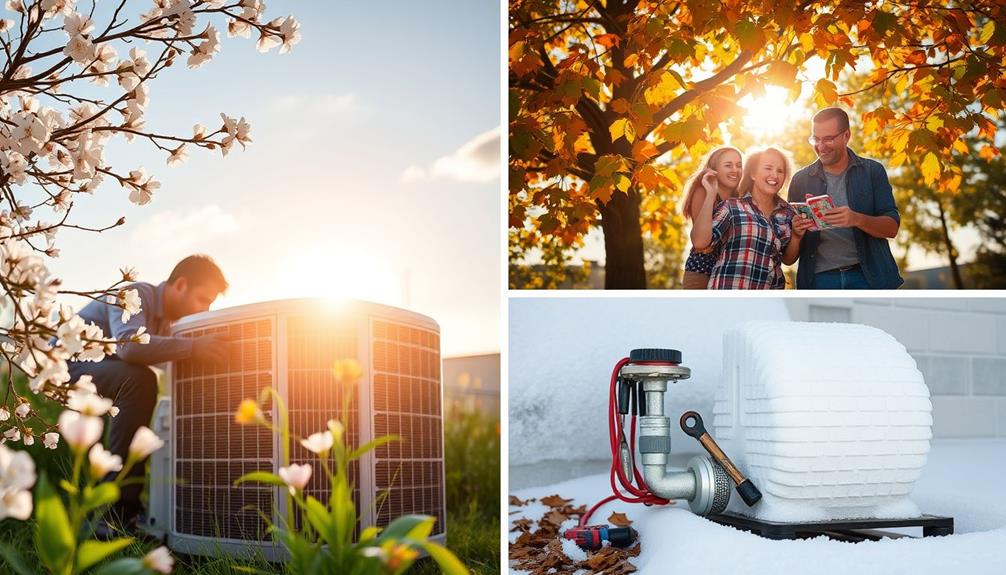
To keep your heat pump running smoothly year-round, seasonal maintenance is key. In spring, clean filters and inspect outdoor coils. During summer, raise your thermostat a few degrees to save energy and keep the area around the unit clear. Fall's all about preparing for colder months, so schedule a professional check and secure outdoor panel covers. In winter, guarantee snow and ice aren't blocking airflow and check the defrost cycle. By staying on top of these tasks, you'll enhance efficiency and prolong your system's lifespan, and there are more detailed tips to guarantee peak performance throughout the year.
Key Takeaways
- Spring maintenance includes cleaning filters, inspecting coils, and testing thermostats to ensure optimal performance as temperatures rise.
- Summer efficiency can be improved by adjusting thermostat settings and maintaining a clean environment around the heat pump.
- Fall preparation involves clearing debris, scheduling professional maintenance, and checking filters to enhance airflow and performance.
- Winter protection measures include inspecting the defrost cycle, keeping drainage lines clear, and ensuring proper insulation to prevent energy loss.
- Year-round maintenance practices, such as regular cleaning and professional inspections, significantly enhance system performance and extend the heat pump's lifespan.
Spring Maintenance Tasks
As spring arrives, it's essential to give your heat pump some much-needed attention to guarantee it operates efficiently during the warmer months.
Start by cleaning filters monthly; this simple task helps maintain ideal indoor air quality and assures proper airflow. Additionally, regular maintenance can prevent common causes of heat pump failures such as refrigerant leaks and electrical issues, which can be detrimental as temperatures rise.
Next, inspect outdoor coils for debris and dirt. A clean coil will enhance efficiency and improve heat exchange performance, allowing your system to work effectively.
Don't forget to test thermostat functionality. Accurate temperature control is critical as temperatures begin to rise. You should also check refrigerant levels and inspect for leaks, since low refrigerant can greatly affect your heat pump's efficiency and overall performance.
Understanding thermal energy transfer basics can also help in identifying potential issues with your system.
Scheduling professional maintenance in spring is a smart move. A technician can address any potential issues and fine-tune your system for the upcoming cooling season.
They'll also provide a thorough inspection to guarantee everything's running smoothly.
Summer Efficiency Tips
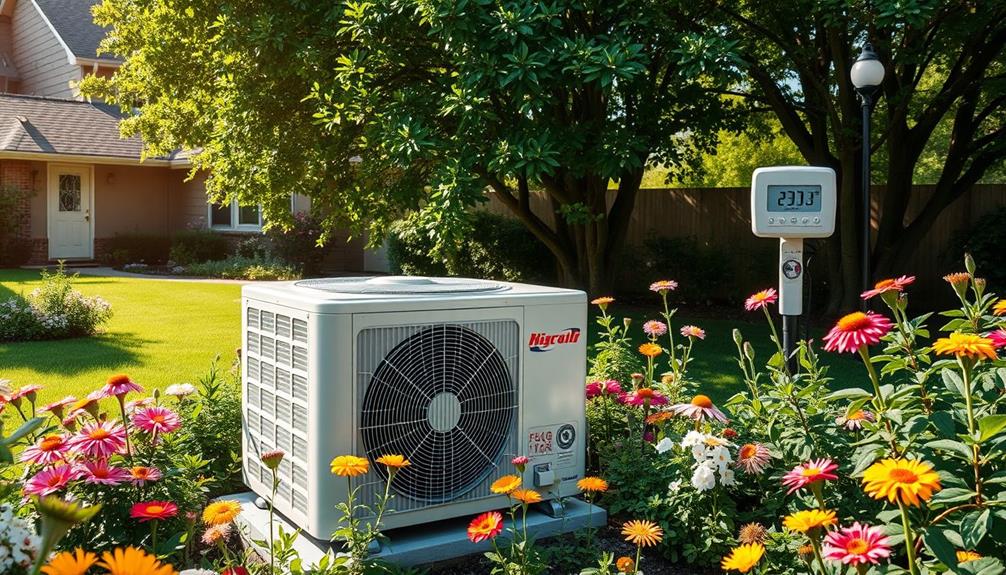
Keeping your heat pump running efficiently during the summer months requires some proactive steps. Start by adjusting your thermostat settings; raising it just a few degrees can lead to energy savings of 3% to 5% for each degree increase.
Additionally, consider the importance of maintaining a clean environment around your heat pump, as it can greatly impact its performance; this is similar to how essential home cleaning kit items contribute to an effective cleaning routine.
Next, make sure to clean or replace your air filters monthly. A clogged filter can reduce efficiency by 15% to 20% and spike your energy bills.
Pay attention to your outdoor unit, ensuring there's at least a 24-inch clearance around it. This helps prevent overheating and maintains ideal airflow.
Don't forget to regularly check and clear the condensate drain to avoid clogs, which can cause water damage and lead to system failure.
Lastly, consider scheduling professional maintenance during the summer. A technician can clean coils and check electrical connections, boosting your heat pump's efficiency and extending its lifespan.
Fall Preparation Steps

Preparing your heat pump for fall is crucial to guaranteeing it operates efficiently during the colder months. To get your system ready, you'll need to focus on maintenance tasks that enhance energy efficiency and seasonal comfort.
Regular maintenance with the right equipment can greatly prolong the life of your heat pump, much like how pool maintenance equipment guarantees a clean and comfortable swimming environment.
Here are some essential steps to follow:
- Clear debris around the outdoor unit, maintaining at least a 24-inch clearance for ideal airflow.
- Schedule professional maintenance to inspect electrical connections and lubricate motors, verifying everything runs smoothly.
- Check and secure panel covers on the outdoor unit to prevent air leaks.
Don't forget to inspect the filters and replace them if necessary, as clean filters improve airflow and system performance.
Additionally, consider a professional tune-up to clean coils and check refrigerant levels. This guarantees your heat pump operates effectively and helps prevent issues during peak heating demand.
Winter Protection Measures

During winter, protecting your heat pump is vital for maintaining its efficiency and avoiding costly repairs. One of the key winter protection measures is to regularly inspect the defrost cycle. This prevents frost buildup on the outdoor coil, which can seriously hinder performance.
Additionally, make sure that the base pan and condensate drainage lines are clear and functioning properly to avoid water backup that could lead to system failure. Utilizing an ozone air purifier can also help maintain better indoor air quality, complementing your heating system during the colder months.
Keep the area around your heat pump clear of snow and ice, maintaining at least 18-24 inches of clearance for airflow. This helps prevent overheating and guarantees your system operates efficiently.
Don't forget to check the insulation on refrigerant lines; proper insulation minimizes energy loss and maximizes maintenance efficiency during the winter months.
Scheduling professional servicing before winter is essential. This includes a thorough check of electrical connections and lubrication of moving parts, helping to prevent unexpected failures when you need your heat pump most.
Year-Round Maintenance Practices

To maintain your heat pump's efficiency year-round, regular maintenance is essential. This helps guarantee peak performance and energy efficiency, keeping your home comfortable in all seasons.
Start with regular cleaning of both indoor components and outdoor units to prevent dirt buildup, which can reduce efficiency by up to 30%. Additionally, staying informed about the benefits of diversification in your investments can enhance your overall financial planning, much like regular maintenance enhances your heat pump efficiency.
- Inspect insulation around refrigerant lines to minimize energy loss.
- Test the emergency heat mode regularly for reliability during unexpected issues.
- Schedule professional maintenance at least once a year to catch potential problems early.
Keeping a detailed maintenance log is key. It helps you track service dates and tasks completed, which can be beneficial for warranty claims and resale value.
By staying proactive with maintenance, you can enhance your heat pump's longevity and efficiency, guaranteeing it performs well when you need it most. Regular attention to these practices not only promotes seasonal comfort but also protects your investment in the system.
Make certain your heat pump is ready for any season by committing to these year-round maintenance practices.
Importance of Pre-Season Care

Pre-season care for your heat pump is vital to prevent unexpected failures when you need it most.
Regular maintenance, such as changing filters and checking for leaks, can greatly enhance your system's efficiency and longevity. By addressing issues early, you not only enhance system performance but also boost efficiency, saving you money on energy costs.
Taking proactive steps now guarantees your system's ready to handle extreme weather conditions without a hitch.
Additionally, maintaining proper airflow can prevent strain on the unit and help maintain a comfortable indoor environment, as highlighted in importance of HVAC maintenance.
Preventing Unexpected Failures
Regular maintenance can save you from unexpected heat pump failures when you need your system most. By committing to proactive seasonal care, you can identify potential issues—like leaks, rust, and frayed wires—before they escalate into major problems.
Seasonal inspections guarantee your heat pump operates at peak performance while enhancing energy efficiency. Just as regular toilet maintenance can prevent leaks and extend the lifespan of your plumbing system, seasonal checks on your heat pump are equally crucial for overall home comfort and efficiency toilet maintenance benefits.
Here are some key benefits of regular maintenance checks:
- Prevent unexpected failures: Catch minor issues early to avoid costly repairs.
- Improve indoor air quality: Addressing leaks and ductwork problems keeps your air clean and comfortable.
- Extend lifespan: Routine care helps your heat pump last longer, saving you money in the long run.
Studies show that effective maintenance can reduce energy costs by 5% to 40%, making it necessary for both your wallet and comfort.
Enhancing System Performance
A well-maintained heat pump is vital for ideal system performance and energy efficiency. Regular seasonal maintenance enhances energy efficiency by as much as 40%, leading to considerable savings on your utility bills.
By investing in pre-season care, you're not just preventing unexpected failures; you're also extending your equipment's lifecycle. Just like with your pets, dog health and care requires attention to guarantee they thrive.
During these checks, professionals can address issues like leaks, rust, and frayed wires, which are essential for guaranteeing proper airflow and consistent temperature regulation throughout the year.
Additionally, maintaining optimal refrigerant levels and verifying thermostat accuracy helps prepare your heat pump for seasonal demands, reducing the risk of breakdowns.
Moreover, seasonal maintenance can greatly improve indoor air quality. Clean ducts free from blockages enhance airflow, providing a more comfortable living environment.
Benefits of Regular Maintenance

Regular maintenance of your heat pump can lead to significant cost savings by improving energy efficiency and preventing costly repairs.
By adhering to a consistent maintenance schedule, you can also benefit from insights on meal planning and nutritious recipes, which can parallel your efforts to guarantee a comfortable home environment.
You'll not only spend less on utility bills, but you'll also extend the lifespan of your system by catching small issues before they become major problems.
Keeping up with maintenance guarantees your home stays comfortable and your investment remains protected.
Cost Savings Benefits
Maintaining your heat pump isn't just about comfort; it can also lead to significant cost savings. By investing in professional maintenance, you guarantee your system operates at peak energy efficiency, which can translate to energy savings of 5% to 40%.
Regular cleaning of filters and ducts not only enhances indoor air quality but also reduces health-related costs, making your home a safer place. Additionally, incorporating technology in your maintenance routines can foster a more proactive approach to home care, similar to how families can explore online platforms for creativity enhancement in their digital projects.
Consider these cost-saving benefits of seasonal maintenance:
- Identify minor issues early: Prevent small problems from escalating into expensive repairs, saving you hundreds in emergency service calls.
- Meet warranty requirements: Consistent maintenance helps you stay compliant with manufacturer guidelines, protecting you from unexpected repair costs.
- Proactive care: Extend the lifespan of your heat pump by up to 25%, delaying the need for costly replacements.
Enhanced System Lifespan
Investing in seasonal maintenance can extend your heat pump's lifespan by an impressive 5 to 15 years. Regular inspections allow you to prevent issues before they escalate, ensuring your system operates efficiently. When you schedule routine servicing, you're not just cleaning; you're enhancing energy efficiency by 5% to 40%. This means lower energy bills and fewer breakdowns, which can cut your repair costs by up to 30% over time.
Here's a quick overview of the benefits:
| Benefit | Description |
|---|---|
| Extended Lifespan | Up to 15 years longer with regular care |
| Reduced Repairs | 30% less on average due to fewer breakdowns |
| Improved Efficiency | 5% to 40% more energy efficient |
| Routine Inspections | Catch small issues before they become big |
| Optimal Performance | Keeps your heat pump running smoothly |
Frequently Asked Questions
What Is Routine Maintenance for a Heat Pump?
Routine maintenance for a heat pump involves cleaning or replacing filters monthly, inspecting outdoor coils yearly, checking refrigerant levels, testing thermostat functionality, and scheduling professional inspections to guarantee efficient operation and prevent costly repairs.
How Do You Maintain a Heat Pump in the Winter?
Picture a winter wonderland, but your heat pump's struggling beneath ice. You'll want to check for frost, clear outdoor airflow, adjust your thermostat, and schedule a professional inspection to keep your home cozy and warm.
What Should the Heat Pump Schedule Be in the Winter?
In winter, you should check your heat pump weekly for ice accumulation, guarantee indoor components are clean, adjust the thermostat for efficiency, monitor for unusual noises, and replace air filters regularly to maintain peak performance.
How Does a Heat Pump Work in the Summer and Winter Months?
In summer, your heat pump cools your home by extracting indoor heat and releasing it outside. In winter, it reverses, drawing heat from outside air to warm your space, even in low temperatures.
Conclusion
By staying on top of seasonal maintenance for your heat pump, you guarantee it runs efficiently year-round. Regular care not only extends the life of your system but also saves you money on energy bills. Have you ever considered how a little effort now can prevent major headaches later? Embrace these maintenance tips and watch your comfort levels soar, knowing you're making a smart investment in your home's heating and cooling system.
Home Heating Solutions
Heat Pump Refrigerants: Environmental Impacts and Future Alternatives
The environmental impacts of heat pump refrigerants are significant, but innovative alternatives are emerging—discover what the future holds for sustainable cooling solutions.

Heat pump refrigerants are essential for HVAC efficiency, but their environmental impacts can't be ignored. Many common options, like HFCs, have high Global Warming Potential (GWP), contributing considerably to climate change. Fortunately, natural refrigerants such as propane and ammonia are becoming popular alternatives, offering lower GWP and fewer environmental risks. Regulatory measures like the Kigali Amendment are pushing the market towards these sustainable solutions. While there are challenges, the trend is clearly shifting towards eco-friendly options. By exploring further, you'll uncover more about innovative technologies shaping the future of refrigerants and how they can help combat climate change.
Key Takeaways
- High-GWP refrigerants like HFCs significantly contribute to climate change, necessitating a shift towards lower-GWP alternatives.
- Natural refrigerants, such as propane (R290), offer minimal environmental impact with a GWP of just 3.
- Regulatory frameworks, such as the Kigali Amendment, aim to phase down high-GWP refrigerants, promoting sustainable alternatives.
- HFOs, while marketed as eco-friendly, pose risks due to harmful byproducts like trifluoroacetic acid (TFA).
- Adoption of innovative, low-GWP refrigerants can enhance energy efficiency and provide long-term economic benefits despite higher upfront costs.
Overview of Heat Pump Refrigerants
Understanding heat pump refrigerants is essential for anyone involved in HVAC systems. These refrigerants play a vital role in heat pump technology, transferring heat efficiently to provide heating and cooling. Common refrigerants include hydrofluorocarbons (HFCs) like R410A and R134a, which are popular due to their effectiveness. However, they come with a high Global Warming Potential (GWP), which has led to regulatory actions aimed at phasing them down.
Heat pump failures can often be traced back to issues related to refrigerant levels, underscoring the importance of using the right materials.
As climate change becomes an increasing concern, the shift toward natural refrigerants is gaining momentum. Options like propane (R290) and CO₂ are emerging, offering considerably lower GWP and reduced environmental impact compared to traditional HFCs. This change is supported by international agreements such as the Kigali Amendment, which seeks to cut greenhouse gas emissions from refrigerants.
The focus on refrigerant innovation is vital for the future of HVAC systems. Ongoing research is developing sustainable alternatives that maintain efficiency while minimizing environmental harm.
Environmental Impact of Refrigerants

When you consider the environmental impact of refrigerants, it's essential to understand their Global Warming Potential (GWP) and how they contribute to climate change.
The energy sources used in producing and operating refrigeration systems, such as geothermal energy generation, can further influence their overall environmental footprint.
While HFOs might seem like a greener option, they can create harmful byproducts like trifluoroacetic acid.
Switching to natural refrigerants like propane and ammonia offers a sustainable solution with minimal environmental risks.
GWP and Climate Change
Refrigerants play an essential role in climate change due to their varying Global Warming Potential (GWP), which measures their impact on global warming relative to carbon dioxide. Some refrigerants, like HFC-134a, have a staggering GWP of 4,144 over 100 years, showing just how significant their environmental impact can be.
As you consider the implications of these substances, think about the following:
- HFCs contribute to up to 0.5°C of global warming, threatening our planet's future. Additionally, the shift to more sustainable options can help in achieving tax advantages associated with IRA accounts for investors focused on eco-friendly practices.
- Sulfur hexafluoride (SF6) has a GWP of 22,800, making it one of the most dangerous greenhouse gases.
- Switching to natural refrigerants, like propane (R290) with a GWP of just 3, can drastically reduce your carbon footprint.
The urgency to address high-GWP refrigerants is clear, especially with initiatives like the Kigali Amendment aiming to phase them down.
HFOs and TFA Risks
As the industry shifts towards alternatives to high-GWP refrigerants, Hydrofluoroolefins (HFOs) have emerged as seemingly eco-friendly options. However, their use brings significant environmental risks, particularly regarding the production of trifluoroacetic acid (TFA).
Understanding the impact of narcissistic abuse can shed light on how harmful behaviors can have long-lasting effects, much like the environmental consequences of these refrigerants. HFO refrigerants like HFO-1234yf are projected to generate five times more TFA than traditional HFC-134a. If widely adopted, this could lead to a staggering 33-fold increase in TFA levels, raising serious concerns about sustainability.
TFA is a persistent environmental contaminant that accumulates in water bodies and can linger for up to 30 years, threatening aquatic ecosystems. Recent studies highlight a worrying trend, revealing a four-fold rise in TFA deposition in rainwater from 2018 to 2020 compared to levels from 1995/1996. This indicates that the adoption of HFOs is contributing to escalating TFA pollution.
Moreover, the potential for HFO emissions to form HFC-23, an extremely potent greenhouse gas with a GWP of 14,800, adds another layer of concern. As you consider the environmental impacts of refrigerants, it's essential to weigh the long-term effects of HFOs against their intended benefits.
Natural Refrigerants Benefits
A growing number of businesses and consumers are turning to natural refrigerants like propane (R290) and ammonia (R717) for their remarkable environmental benefits.
These options not only help combat climate change but also improve energy efficiency in significant ways. Additionally, using air purifiers can further enhance indoor air quality by reducing allergens and pollutants, contributing to a healthier environment overall air quality indicators.
Consider these key advantages:
- Lower Global Warming Potential (GWP): R290 has a GWP of just 3, while HFC refrigerants can exceed 4,000. This means you'll be contributing to a healthier planet.
- Non-Ozone-Depleting: Natural refrigerants are often non-ozone-depleting, leading to better air quality and a reduced risk of environmental harm.
- Enhanced Energy Efficiency: You can expect 10-15% improvements in energy efficiency over traditional HFC systems, saving you money on energy bills.
Global Warming Potential Explained

Global Warming Potential (GWP) is an essential measure that helps you understand how different greenhouse gases trap heat in the atmosphere over time.
By looking at the GWP of common refrigerants, you can see how some, like HFCs, contribute notably to climate change compared to others.
Recent discussions emphasize the need for cybersecurity challenges that can arise from improper management of refrigerants and their environmental impacts.
Understanding these implications can guide your choices in selecting more environmentally friendly options for heat pumps.
GWP Definition and Calculation
Understanding Global Warming Potential (GWP) is essential for grasping how different greenhouse gases impact climate change. GWP quantifies the warming effect of gases over a specific timeframe, with carbon dioxide (CO₂) as the baseline reference, assigned a GWP of 1. The calculation considers a gas's ability to absorb infrared radiation and its atmospheric lifespan.
In evaluating environmental impacts, it's important to be aware of protecting savings through informed choices regarding technologies that utilize refrigerants.
Here are three key points to remember about GWP:
- Cumulative Impact: High GWP gases can cause considerably more warming than CO₂, making their regulation important for climate health.
- Time Sensitivity: Methane, for example, has a GWP of 83 over 20 years but drops to 30 over a century, highlighting the urgency of reducing emissions quickly.
- Standardized Reporting: The Kyoto Protocol mandates using IPCC GWP values, ensuring consistent reporting and facilitating effective climate action.
Understanding GWP helps you evaluate the refrigerants used in heat pumps, especially those with low GWP options.
Choosing low GWP refrigerants is essential in reducing the overall global warming potential and mitigating climate change impacts.
GWP of Common Refrigerants
Evaluating the GWP of common refrigerants reveals considerable differences in their environmental impact. The Global Warming Potential (GWP) measures how much heat a gas can trap in the atmosphere over a specific timeframe compared to carbon dioxide, which has a GWP of 1.
For instance, hydrofluorocarbons (HFCs) like R410A and R134a have high GWPs of 2,088 and 1,430, respectively. Their substantial contribution to climate change highlights the need for alternatives. Shifting to investments in more sustainable practices, similar to how gold acts as a hedge against inflation, can also support environmental initiatives.
In contrast, some refrigerants have lower GWPs, making them more environmentally friendly choices. For instance, while methane has a GWP of 83 over 20 years, nitrous oxide's GWP reaches 273.
Sulfur hexafluoride (SF₆) stands out with a staggering GWP of 22,800, making it exceptionally harmful.
Recognizing these values is essential, especially with the Kigali Amendment to the Montreal Protocol in play, which aims to phase down HFCs. By moving to refrigerants with lower GWPs, we can greatly reduce our environmental impact and contribute to global efforts to combat climate change.
Understanding the GWP of these substances is a fundamental step toward making informed choices.
Regulatory Implications of GWP
The varying GWP of refrigerants has significant regulatory implications that shape how countries address climate change. As you navigate these complex frameworks, it's essential to understand how GWP values influence decisions.
Regulations like the Montreal Protocol and its Kigali Amendment specifically target high-GWP hydrofluorocarbons (HFCs), pushing for their phasedown. The shift towards greener alternatives can be likened to the need for financial diversification in retirement planning, where diversification of retirement portfolio enhances financial security.
Here are three emotional impacts of these regulations:
- Environmental Responsibility: You can contribute to healthier ecosystems by supporting low-GWP alternatives.
- Economic Benefits: Investing in newer, more efficient refrigerants can save costs in the long run.
- Public Health: Reducing high-GWP refrigerants leads to cleaner air and a safer environment for future generations.
Alternatives to Traditional Refrigerants
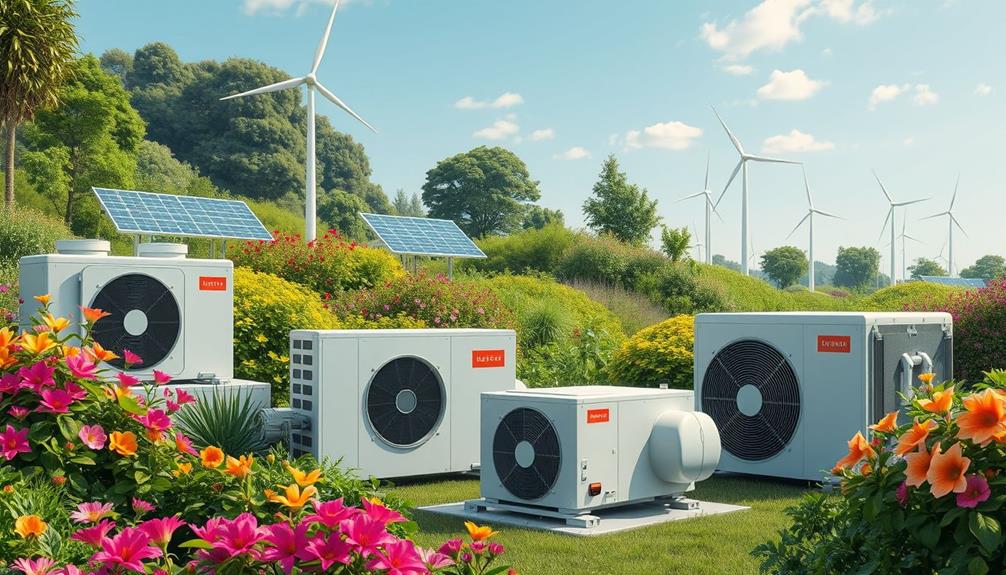
Increasingly, industry experts are turning to alternatives to traditional refrigerants due to their environmental impact. Natural refrigerants like propane (R290) and ammonia (R717) stand out because they've markedly lower global warming potential (GWP) compared to hydrofluorocarbons (HFCs). For instance, R290 boasts a GWP of just 3, while R717 has a GWP of 0.
This change not only addresses environmental concerns but also enhances energy efficiency in heat pump systems, often yielding 10-15% higher efficiency than HFOs. Regular updates to the regulations surrounding refrigerants are essential for staying compliant and informed about the best options available.
While hydrofluoroolefins (HFOs) are marketed as low-GWP options, they still raise red flags due to their potential to produce harmful degradation products like trifluoroacetic acid (TFA). Consequently, the movement towards natural refrigerants and other innovative solutions, including bio-based refrigerants, is gaining traction.
The EU F-Gas Regulation is a vital driver of this change, emphasizing the need to phase out high-GWP substances. By adopting these alternatives, you contribute to a more sustainable future while ensuring compliance with evolving regulatory frameworks.
Embracing these innovative refrigerants can lead to both environmental benefits and improved system performance.
Evolution of Refrigerant Types

As the push for eco-friendly solutions continues, the evolution of refrigerant types has taken center stage in the industry. You might remember the days when chlorofluorocarbons (CFCs) were commonplace, only to be phased out due to their role in ozone depletion.
Today, hydrofluorocarbons (HFCs) like R410A and R134a emerged as alternatives, boasting zero ozone-depletion potential but carrying high global warming potential (GWP).
Now, the focus is shifting towards more sustainable options, including natural refrigerants such as propane (R290) and ammonia. These alternatives greatly lower the overall GWP, making them appealing for heat pumps and other cooling systems.
Consider these crucial points:
- Ozone Depletion: Many refrigerants have historically harmed our ozone layer.
- Climate Change: High-GWP refrigerants contribute to global warming, threatening our planet.
- Sustainable Future: Natural refrigerants offer hope, balancing efficiency with environmental responsibility.
The ongoing evolution reflects a commitment to sustainability, aiming to minimize environmental impact while ensuring energy efficiency.
Adopting these newer refrigerants is essential for a healthier planet and a more sustainable future.
Regulatory Framework and Compliance

Maneuvering the regulatory framework surrounding refrigerants can be complex, especially with the ongoing changes aimed at reducing greenhouse gas emissions. As someone involved with heat pump systems, you'll need to stay updated on the EU F-Gas Regulation, which mandates a phasedown of hydrofluorocarbons (HFCs) due to their high global warming potential (GWP).
By 2015 levels, the goal is a 45% reduction in CO2-equivalent emissions from the HFC market.
Additionally, the Kigali Amendment to the Montreal Protocol establishes global commitments to curb HFC production and consumption, creating a phasedown schedule that impacts your compliance obligations.
It's important to understand that environmental standards vary by country, affecting which refrigerants you can legally use.
Recent reports of illegal HFC imports into the EU equivalent to 73 million tonnes of CO2 underscore the regulatory challenges you may face in ensuring compliance.
As regulations evolve, future restrictions may also target hydrofluoroolefins (HFOs) due to rising environmental concerns, including harmful byproducts like trifluoroacetic acid (TFA).
Staying informed and proactive about these changes is vital for managing the regulatory landscape effectively.
Natural Refrigerants: Benefits and Challenges

Natural refrigerants are gaining traction as eco-friendly alternatives to synthetic options in heat pump systems. With benefits like lower global warming potential (GWP), they're becoming increasingly popular.
Consider these compelling reasons to switch:
- Lower GWP: Propane (R290) has a GWP of just 3, while ammonia's GWP is 0, making them far less harmful to the environment.
- High Energy Efficiency: Natural refrigerants achieve impressive coefficients of performance (COPs) between 5 to 10, especially in systems that utilize waste heat.
- Regulatory Compliance: Using natural refrigerants helps you stay ahead of regulations targeting high-GWP substances, aligning with global climate goals.
However, challenges exist. Propane's flammability and ammonia's toxicity require careful handling, safety measures, and thoughtful system design.
These factors can deter some from adopting these refrigerants. Yet, as technological advancements continue to improve performance outcomes, the acceptance of natural refrigerants is on the rise.
Embracing these alternatives not only benefits the environment but also enhances your system's efficiency and future-proofing.
Market Trends and Economic Considerations
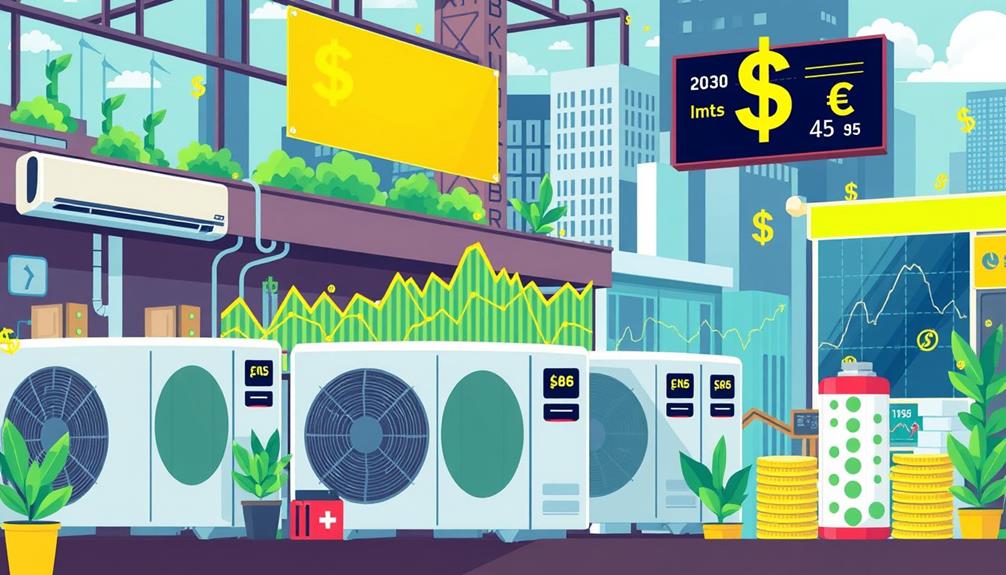
The shift towards low-GWP refrigerants is reshaping the heat pump market, driven by regulatory pressures and a growing demand for sustainable solutions.
As you consider investing in a heat pump system, keep in mind that regulations like the EU F-Gas Regulation are pushing manufacturers to phase down HFCs. This not only affects market dynamics but also influences pricing strategies.
Natural refrigerants, such as propane and CO2, are emerging as cost-effective alternatives due to their lower environmental impact and the absence of taxes that typically burden high-GWP options.
While the upfront costs of heat pump systems using low-GWP refrigerants may be higher, the typical payback period is around five years, thanks to energy savings that align with sustainable building practices.
With increasing market demand for eco-friendly solutions, there's significant investment in innovative refrigerant technologies.
Manufacturers are keen to meet sustainability goals while remaining competitive, ensuring that natural refrigerants will likely dominate future HVAC solutions.
Future Directions in Refrigerant Innovation

Innovatively, researchers are continually exploring new refrigerant options that promise to reduce environmental impact and enhance efficiency.
The HVAC industry is at a pivotal moment, as the demand for sustainable solutions grows. Natural refrigerants, like propane and ammonia, stand out for their notably lower GWP and reduced environmental impact compared to synthetic alternatives.
As you consider the future of refrigerants, think about these essential aspects:
- Embracing Nature: Utilizing natural refrigerants can lead to a positive environmental shift, minimizing harmful emissions.
- Policy Support: Upcoming regulations and government incentives will drive innovation, accelerating the adoption of low-GWP refrigerants.
- Smart Integration: Combining innovative refrigerants with smart HVAC technologies can considerably lower energy needs and indirect emissions.
The analysis of current technologies shows a lack of fundamentally new chemical classes, making the exploration of bio-based and natural refrigerants essential for sustainability.
By focusing on these innovative refrigerants, you can help shape a future that prioritizes both efficiency and environmental stewardship.
Embrace the change; the future of refrigerants is bright and green.
Frequently Asked Questions
Are Heat Pump Refrigerants Bad for the Environment?
Yes, heat pump refrigerants can harm the environment. Many contain high global warming potential substances, which contribute to climate change. You should consider eco-friendly alternatives to minimize your impact and support sustainable practices in heating systems.
What Are Alternative Refrigerants for Heat Pumps?
You can consider natural refrigerants like propane and ammonia, or low-GWP options such as HFOs and carbon dioxide. These alternatives help reduce environmental impact while maintaining efficiency in heat pump applications. Explore your options!
What Is the Most Environmentally Friendly Refrigerant?
When it comes to being green, using natural refrigerants like propane or ammonia is your best bet. They've got low global warming potential, making them friendlier to the environment than traditional high-GWP options.
What Is the Most Environmentally Friendly Refrigerant?
The most environmentally friendly refrigerant for you is propane (R290) or ammonia (R717). Both offer considerably lower global warming potential and enhance energy efficiency, helping you reduce emissions and contribute positively to climate change efforts.
Conclusion
As we navigate the complex landscape of heat pump refrigerants, it's clear that the choices we make today can shape a more sustainable tomorrow. Embracing natural refrigerants and innovative alternatives isn't just a trend; it's a necessity. So, wouldn't you agree that our future depends on how we respond to these environmental challenges? By pushing for better options, we can cool our homes without heating up the planet—an investment worth making for generations to come.
-

 Residential and Commercial Applications5 months ago
Residential and Commercial Applications5 months agoBest Amana Heat Pump Reviews
-

 Thermal Energy Transfer5 months ago
Thermal Energy Transfer5 months agoBreakthroughs in Modern Heat Pump Systems: Thermal Energy Edition
-

 Residential and Commercial Applications5 months ago
Residential and Commercial Applications5 months agoBest Heat Pump
-

 Geothermal Heat Pumps4 months ago
Geothermal Heat Pumps4 months agoUpgrade Your Comfort with Our Efficient HVAC Systems
-

 Geothermal Heat Pumps5 months ago
Geothermal Heat Pumps5 months agoInnovative Geothermal Heat Pump Manufacturers Revolutionize Energy Efficiency
-

 Air Conditioning4 months ago
Air Conditioning4 months agoExploring Energy-Efficient Air Conditioning Heat Pumps
-

 Thermal Energy Transfer2 months ago
Thermal Energy Transfer2 months agoBoost Your Heat Pump Efficiency: Interactive Guide
-

 Air Conditioning5 months ago
Air Conditioning5 months agoHeat Pumps Outperform Traditional Heating in Energy Use











